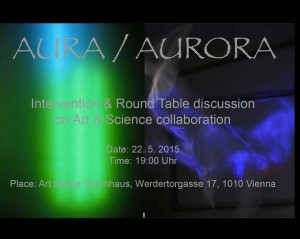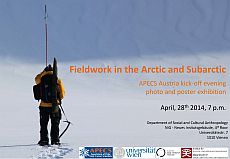The Arctic and Subarctic Working Group Photography Blog: Cities, Transportation, People and Everyday Life
This blog features photographs from Austrian scientists working in the Arctic and Subarctic: https://aas.photo.blog/
This blog features photographs from Austrian scientists working in the Arctic and Subarctic: https://aas.photo.blog/
 Durchhaus Art Space, Werdertorgasse 17, 1010 Vienna
Durchhaus Art Space, Werdertorgasse 17, 1010 Vienna
A Polar evening with a panel discussion on the magnificent Aurora Borealis in science & art and a review of Canada’s Arctic Council chairmanship 2013-2015. Hosted by A.A.S., the Canadian Embassy and other Arctic related partners.
Detailled invitation: Aurora Event 22052015_invitation [pdf]
The breath-taking Polar lights – Aurora – fascinate, scare and raise questions about the unknown. Therefore, they are matters of inquires in natural sciences as well as in the humanities and social sciences. At the same time they inspire societies in creating collective myths, stories and agency. Not least, they inspire artists to reflect, interpret and intervene with this spectacle. This event unravels and contests perceptions of the Aurora phenomena among artists and scientists.
This is the most recent phase of the ongoing art & science project presenting an interactive interpretation of the Polar Lights – Aurora Borealis and Australis, the magnificent and dynamic spectacle that has retained a near-mythical status in circumpolar cultures over millennia. The dazzling geo-physical phenomenon, typically observed in the Circumpolar Regions is not only a brilliant spectacle but it also makes visible the invisible world of electromagnetic activities.
The collaboration between art & science has the potential to create new knowledge, ideas and processes. New ways of seeing, experiencing and interpreting can lead to benefits in both fields. This round-table discussion aims to explore trans-disciplinary collaborations within the creative process of art, science and technology in the context of the Polar Lights.
Dr. Gerti Saxinger (Department for Social and Cultural Anthropology & Austrian Polar Research Institute APRI),
Doris Kaltenbacher (Durchhaus Art Space):
Introduction by the hosts Mark Bailey, Ambassador of Canada to Austria: “The Arctic, its economic and social development: Looking back on Canada’s achievements for the People of the North during its Arctic Council chairmanship 2013-2015”
Canadian Arctic images
Panel Discussion: Aura/Aurora – a science and arts perspective
Food and Wine Reception
Registration (organisational reasons only):
Gertrude.eilmsteiner-saxinger@univie.ac.at
Bettina Schülke, Artist, PhD Cand., University of Lapland, Faculty of Art and Design
Nina Czegledy, Artist, Curator, Senior Fellow University of Toronto, Concordia University Montreal, Hungarian University of Fine Arts.
Dr. Stefan Donecker, Austrian Academy of Sciences, Institute for Medieval Research.
Dr. Margarete Jahrmann, Artist, Curator, Dozentin for Game-Design, ZHdK Zürich, University of Fine Arts Vienna.
Dr. Werner Gruber, Lecturer, Institute for Experimental Physics, University of Vienna and Director of the Planetarium Vienna, Science Busters.
Chair: Dr. Verena Traeger, Curator, Institute for Social- and Cultural Anthropology, University of Vienna & Spokesperson of the “Working Group Circumpolar Regions and Siberia” at the German Association of Anthropologists
Embassy of Canada in Austria
Department for Social and Cultural Anthropology, Uni Vienna
ZKS: Centre for Canadian Studies, Uni Vienna
Durchhaus Art Space
APRI: Austrian Polar Research Institute
AAS: Working Group Arctic and Subarctic
Working Group for Circumpolar & Siberian Regions at German Association of Anthropologists (DGV)
Monday April, 28th 7 p.m.
Department of Social and Cultural Anthropology
NIG – Neues Institutsgebäude, 4th floor
Universitätsstr. 7
1010 Vienna
Opening talks:
Univ. Prof. Dr. Peter Schweitzer
(Department of Social and Cultural Anthropology, Univ. of Vienna, Austrian Polar Research Institute)Univ. Prof. Dr. Andreas Richter
(Department of Department of Terrestrial Ecosystem Research, Univ. of Vienna, Austrian Polar Research Institute)Mag. Sigrid Schiesser
(Department of Social and Cultural Anthropology, Univ. of Vienna, APECS Austria)
 On April 28th, we celebrate the foundation of APECS Austria, which is part of the international and interdisciplinary Association of Polar Early Career Scientists (APECS). APECS provides a platform for interdisciplinary networking and exchange of researchers working in Arctic and Subarctic regions.
On April 28th, we celebrate the foundation of APECS Austria, which is part of the international and interdisciplinary Association of Polar Early Career Scientists (APECS). APECS provides a platform for interdisciplinary networking and exchange of researchers working in Arctic and Subarctic regions.
The photo and poster exhibition “Fieldwork in the Arctic and Subarctic” shows the diversity of Arctic and Subarctic environments, and gives insights into daily lives of residents and researchers. The photographs of the exhibition illustrate the context of research in Polar regions beyond conventional formats of texts, tables and numbers.
The exhibition will be open on workdays from April 28th until May 16th.
We are looking forward to meeting you, APECS Austria
2008
Das Projekt handelt von den Sami in der Region Kiruna, aus den Gemeinden Laevas und Gabna. Den Sommer verbringen die Rentierzüchtenden Sami im Hochgebirge, nahe der norwegischen Grenze, um die jungen Kälber zu markieren. Im Winter wandern die Herden Richtung Osten ins Flachland und werden von den Sami wieder in großen Korralen gesammelt und gezählt. Die heutige Kultur der Sami ist geprägt von einer Gratwanderung zwischen der Aufrechterhaltung alter samischer Traditionen und Lebensweisen und dem modernen globalisierten Leben der Majoritätsbevölkerung. Die Bilder porträtieren eine Gesellschaft, die neben den Annehmlichkeiten moderner Technik zur Rentierzucht bemüht ist, das Leben in und mit der Natur zu bewahren. Die Ausstellung wurde 2007 erstmals im Scandinavian Design House in Wien gezeigt.
Our AAS-member Kerstin Schröder, linguist and expert on Scandinavia, did research intensively among the Sami in the north of Sweden. The exhibition presents pictures taken by David Bacher, a Paris based photographer, while their stay among the Sami.
March 6th – 13th , 2008; diverse venues
In March 2008 a photo exhibition about the life in the North with pictures of the Nenets artist Habecha Yaungad is shown in Vienna. Besides the photo exhibition, several lectures and film screenings took place.
These events are dedicated to the nenets, the indigenous people in Russia’s northern arctic region. Habetscha Jaungad, a nenets journalist gives impressions about his culture and life. The events were organized by AAS members.
Im Zuge des Internationalen Polarjahres kam der Künstler und Journalist Habetscha Jaungad nach Wien, um über das Leben und Überleben im Hohen Norden Russlands zu berichten.
Der langjärige Redakteur der nenzischen Zeitung Nar”jana Ngerm und Fotograf war in Wien in mehreren Diskussionsveranstaltungen zu sehen und eröffnete eine Ausstellung mit eigenen Fotografien aus seiner Heimat, dem Land der Nenzen.
6. – 13. März 2008; Russisches Kulturinstitut, Brahmsplatz 8, 1040 Wien
Unter der Anwesenheit des Künstlers findet am Donnerstag, dem 6. März 2008, um 18 Uhr die Vernissage statt.
Montag, 10. März 2008, 19.30 – 20.30 Uhr, Institut für Slawistik der
Universität Wien, Spitalgasse 2, Hof 3, 1090 Wien
Habetscha Jaungad wird anwesend sein und über das Leben in seiner Heimat berichten (Veranstaltung in russ. Sprache).
Dienstag, 11. März 2008, 15 Uhr Institut für Kultur- und Sozialanthropologie der Universität Wien, Universitätsstr. 7, NIG, 4. Stock, 1010 Wien
Prof. Peter Schweitzer (Univ. of Alaska Fairbanks) berichtet über das Internationale Polarjahr (2007-2008) und Habetscha Jaungad über das Leben in seiner Heimat (mit Film).
Mittwoch, 12. März 2008, 18.30 – 21.00 Uhr, Gallery M – Vienna, Arctic Inuit und Native Indian Fine & Decorative Arts,1080 Wien, Strozzigasse 47
Filmpräsentation mit Begrüßung des Fotografen Habecha Jaungad
Habetscha Jaungad steht hier dem Publikum für Fragen zu Verfügung und
berichtet über das Leben in seiner Heimat, dem autonomen Kreis der Jamal
Nenzen (mit Film).
Ein Veranstaltungsreihe der Arbeitsgemeinschaft Arktis und Subarktis
in Kooperation mit:
Bezirksvertretung Wieden
Institut für Slawistik, Univ. Wien
Gallery M
Ges. für bedrohte Völker
Wien Kultur
Inst. f. Kultur- und Sozialanthropologie, Univ. Wien
Institutsgruppe Slawistik, Univ. Wien
Russisches Kulturinstitut Wien
RAIPON
Aut. Gebiet d. Jamalnenzen
Downloadmaterialien zu den Veranstaltungen:
Postkarte (1,9 Mb)
June 9th, 1999, Institute for Social- and Cutural Anthropology (Ethnology), University of Vienna
Artist Anatoli Donkan (Nanai, from the Russian Far East) presents his work of fish-skin processing.
Link: http://www.donkan.de/